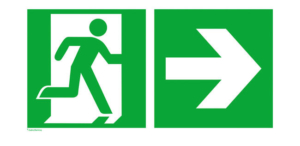Bounce Rate vs. Exit Rate: What’s the Difference

Most companies with an online presence have learned to be wary of a high bounce rate, but most analytics tools also give you information about your exit rate. Although many people tend to use the terms ‘bounce rate’ and ‘exit rate’ interchangeably, they measure different customer behaviors.
Here we show you the difference between the terms, how to calculate the rates, and what you can do to reduce them.
What is Bounce Rate?
A bounce refers to when a user visits a single page on your website and subsequently navigates away from your website without clicking on any other elements on the page. That means the visitor doesn’t click any of the links to another page, leave a comment, or take any of the pathways to an affiliate partner.
What is Exit Rate?
An exit rate refers to when a user visits a page on your website and then navigates away from your website. Exit rate doesn’t care which page they were on or how many other pages they looked at on your website. It just measures the percentage of people who exit your website after viewing a specific page.
What is the Difference and Why is it Important?
Although the definitions of the terms are similar, there is a distinction between the two. Bounce rate measures the percentage of visitors who leave your website before visiting any of your other content. This can be a serious problem if visitors aren’t willing to give the rest of your website a chance and often indicates that your content or product isn’t what they were looking for.
A high bounce rate might suggest that you should look more closely at your content and search engine optimization (SEO) to ensure that your website appears in relevant search results. Visitors may accidentally click on your website looking for an answer to a specific question or for a type of product that you don’t offer.
Focus on targeting the right audience of potential customers: people likely to be interested in your products or services and your company.
On the other hand, the exit rate can help single out pages with irrelevant or poorly created content or poor UX. If a user has been navigating to multiple pages throughout their session and then they leave when they hit a specific page, that’s an indicator that something is frustrating about that page.
Which is More Important?
One rate isn’t more important than another. Product analytics tools can measure both; just remember the metrics tell you different things. They both provide information, as long as you know how to combine these metrics with others to develop actionable goals.
Some companies prefer to focus on exit rate, instead of bounce rate, for deeper insights into why users are leaving their website. High exit rates on product description pages indicate an issue with the product description, graphics, or the product itself. For some reason, interested buyers have seen the page and decided they no longer want your product and left.
That kind of insight can’t come out of bounce rate since it focuses solely on customers who land on your home page or blog and then leave. If your webpage is meant to continue funneling potential customers toward your product pages or check-out, there is likely an issue. Many times, this is due to pathing complications where the user isn’t sure where to click or how to proceed down the conversion funnel.
How to Collect and Use the Data on Your Bounce and Exit Rates
Kissmetrics can help you record bounce and exit rates on your website. The tool will gather the information and generate specific reports based on the timeframe and other parameters you enter.
Analyzing the data requires you to think critically about the page’s content, your website’s goals, and why users are leaving your website after visiting. Websites with blogs usually see a higher bounce rate on average because people will visit, get the information they need, and then leave to continue their business.
How to Calculate Bounce Rate and Exit Rate
The bounce rate is calculated by dividing your total single-page visits by the total number of entrance visits. Exit rate is calculated by dividing your total exits from a page by the total number of visits to a page. This means that every bounce counts as an exit, but not every exit is a bounce.
How Do You Reduce Bounce Rate?
Although bounces are a subset of exits, many websites find that their bounce rate is significantly higher than their exit rate. Considering it’s a piece of the overall exit rate, it seems strange that it would be larger, but it does make sense once you understand the two. Many people will follow links or click-through advertisements that don’t have enough information out of curiosity before deciding they aren’t interested.
A high bounce rate typically indicates some kind of dissatisfaction with the landing page. This isn’t always the case, as is generally not the case with blogs, but there are a few ways to improve a user’s experience with a specific webpage.
One way is to improve the content on the page. You could add more interesting elements to catch the reader’s eye, break up the text into smaller chunks with headers, add clearer calls-to-action, or place graphics throughout the page.
Another way to improve the UX is to quicken the page’s load time. If you have too many visual elements on a page, this can slow down page load time, so try stripping some of the larger files like video from the page to see if that helps. You can also check the code to make sure it’s efficient.
If you suspect your high bounce rate is related to visits from the wrong type of audience, try advertising your website or product to a smaller, more specific audience. Our cohort report looks at page visitors who complete multiple designated events or perform the same events repeatedly. This report allows you to group your customers according to when they first completed an event. This allows you to analyze your customers to see which cohorts are most likely to follow through your sales funnel to purchase and market to them specifically.
How Do You Reduce Exit Rate?
A high exit rate is often a sign of an issue within your sales funnel. The user is visiting multiple pages on your website but, for some reason, is leaving the site before converting. The issue might be one of content. Your product descriptions might be confusing or they might not sufficiently highlight the benefits it brings to the customer. You could also consider lengthening blog posts. Posts that have 300 words or less typically lead to higher exit rates because a person can read them so quickly or they may not contain enough information for the reader.
If your pages have strong content, the problem may lie in your calls-to-action, or lack of them, a complex purchasing process, or something else that is frustrating your would-be customers.
Is There an Acceptable Bounce Rate or Exit Rate?
All companies will have a bounce rate and exit rate. Even the best-structured websites will receive visitors who click out of their pages. It’s essential to consider the content and type of page before deciding that a high bounce or exit rate is necessarily a bad thing.
For example, if you have a sign-up page that requires users to access an email and click on the link you provided there, you would expect the page to have a high exit rate; people need to exit to go to their email. Similarly, the confirmation page that the link takes you to may signify the end of their session for the day.
If a user navigates away to the email, that will be recorded as an exit. By opening the link in the email and getting to the confirmation landing page, that counts as the start of a new session on your website, so if the user then leaves, it will count as a bounce.
Conclusion
Both bounce rates and exit rates for your website’s pages provide information about how your users are experiencing your company. When combined with other metrics, you can use this information to determine which pages need some improvement or where you need to rethink your sales funnel to turn more visitors into customers.
Sources:


